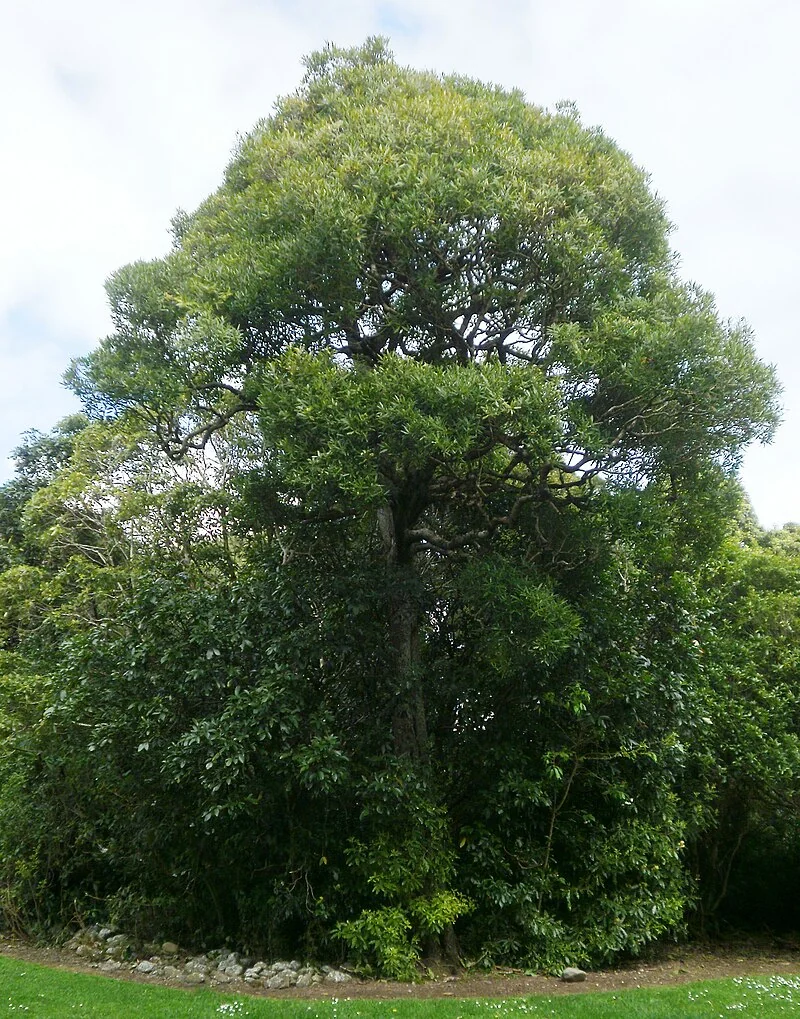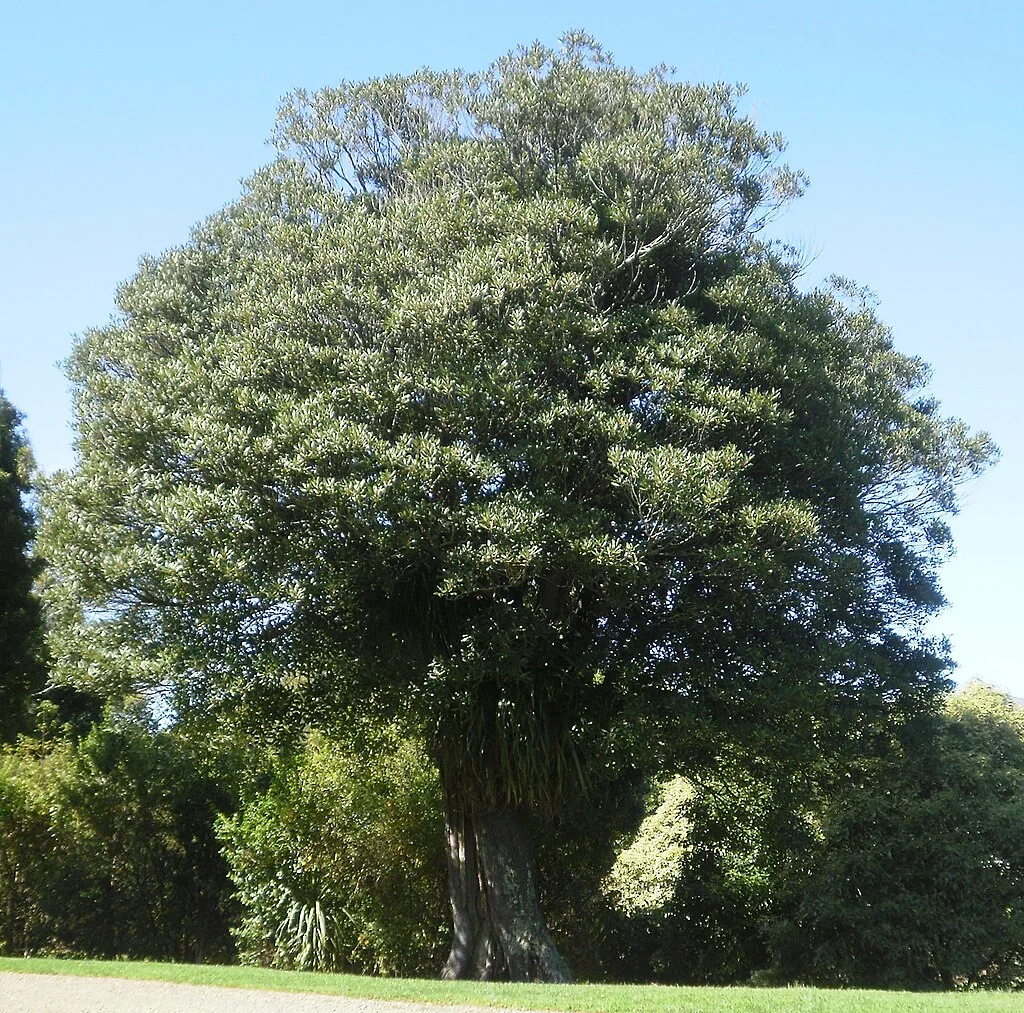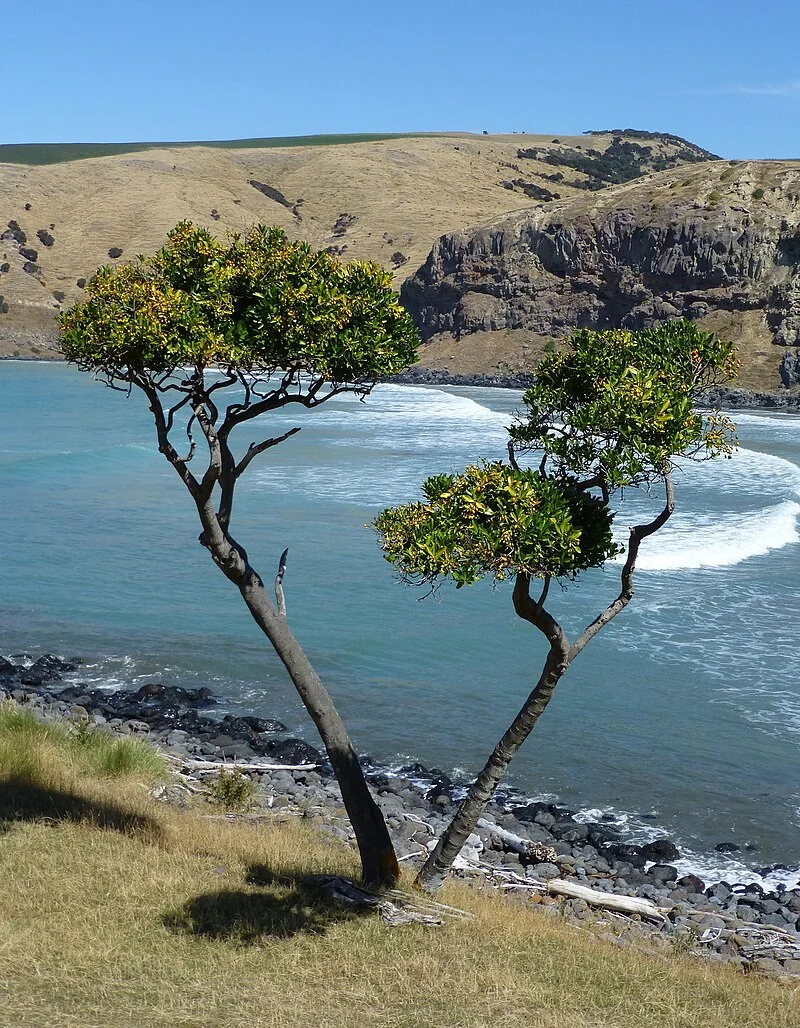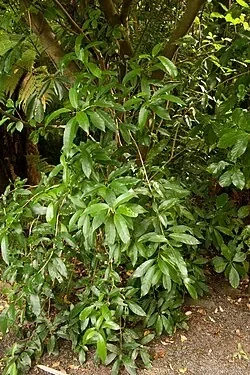
Monoao
Halocarpus kirkii
This native plant, known as Monoao (scientific name: Halocarpus kirkii), is a rare and remarkable conifer species endemic to New Zealand's North Island. It is characterized by its distinctive heteroblastic foliage, specialized kauri forest habitat, and challenging cultivation requirements. This comprehensive guide provides detailed information on its ecology, conservation status, and significance within New Zealand's threatened flora. Understanding this rare species contributes to the appreciation of our unique podocarp heritage and the importance of forest conservation. native trees

Plant Description
Monoao (Halocarpus kirkii) is a rare and distinctive native conifer that can ultimately reach 25 metres in height with a trunk up to 1 metre thick. The tree displays remarkable heteroblastic foliage, meaning it has different leaf forms at different life stages - narrow, leathery leaves up to 4cm long on younger trees and lower branches, transitioning to different forms as it matures.
This endemic New Zealand species is characterized by its grey-brown bark with a rough, pustular texture and its distinctive juvenile foliage that often remains on lower branches until the tree reaches approximately 10 metres tall. The orange-arillate seeds mature over two years and are dispersed by fruit-eating birds.
Quick Facts
| Scientific Name | Halocarpus kirkii |
|---|---|
| Height | Up to 25m |
| Spread | 4-6m |
| Water Needs | Moderate |
| Light | Full sun to part shade |
| Frost Tolerance | Moderate |
| Salt Tolerance | Moderate |
| Growth Rate | Medium |
| Lifespan | Long |
Climate Best Suited to
Monoao (Halocarpus kirkii) is found exclusively in the North Island of New Zealand, with a highly restricted distribution from Te Paki south to near Limestone Downs. This rare native conifer is confined to kauri forest environments between Hokianga Harbour and Coromandel Peninsula. It requires specific climatic conditions that support kauri forests, preferring humid, temperate climates with frequent rainfall and protection from extreme temperatures. Its limited distribution reflects specialized habitat requirements rather than broad climatic adaptability.
Regional Suitability
| City | Climate Suitability |
|---|---|
| Whangārei | Ideal |
| Auckland | Ideal |
| Hamilton | Ideal |
| Tauranga | Ideal |
| Rotorua | Ideal |
| Gisborne | Ideal |
| New Plymouth | Ideal |
| Napier | Ideal |
| Whanganui | Ideal |
| Palmerston North | Ideal |
| Wellington | Ideal |
| Nelson | Ideal |
| Christchurch | Ideal |
| Dunedin | Moderate |
| Invercargill | Moderate |
Plant Habitat
Monoao (Halocarpus kirkii) is endemic to New Zealand's North Island and Great Barrier Island, with a highly restricted distribution from Te Paki south to near Limestone Downs. The species is confined to a small area between Hokianga Harbour and Coromandel, primarily in kauri forest environments.
This naturally sparse species typically occurs in secondary regrowth forest abutting older, intact kauri-dominated remnants. Monoao requires frequent disturbance for regeneration and thrives in areas with past fires, gum digging, or kauri logging, making it poorly suited to climax forest environments long-term.
Plant Conservation
Monoao (Halocarpus kirkii) has a conservation status of "At Risk - Naturally Uncommon" as of 2023, and is "At Risk - Regionally Relict" in the Auckland region. This species appears to have never been common and maintains a highly fragmented, sporadic distribution even within intact tracts of its preferred habitat.
The species' rarity is worsened by its specific ecological requirements and its tendency for sudden collapse even when well-established. Conservation efforts focus on protecting existing populations in reserves like Waipoua and Puketi forests, while understanding its disturbance-dependent regeneration patterns is crucial for effective management.
Growing Requirements
Soil Requirements
White maire (Nestegis lanceolata) is remarkably adaptable to different soil conditions, thriving in well-drained environments. It can tolerate a variety of soil types, from sandy to loamy, and prefers a neutral to slightly acidic pH. Good drainage is crucial to prevent root rot, ensuring healthy growth and development.
- Tolerates a wide range of soil types from clay to sandy
- Prefers well-draining soils but can handle occasional waterlogging
- Thrives in moderately fertile soils but will grow in poor soils too
- Can tolerate slightly acidic to slightly alkaline pH
- Handles coastal conditions including salt spray
Light Requirements
White maire (Nestegis lanceolata) thrives in a variety of light conditions, from full sun to partial shade. Optimal growth and flowering are typically achieved in locations receiving ample sunlight throughout the day. However, it can also tolerate some shade, especially in hotter climates, where it benefits from protection during the most intense afternoon sun.
- Full sun for optimal growth and form
- Can tolerate partial shade but may develop a leggier form
- At least 6 hours of direct sunlight daily is ideal
- Northern or eastern exposures work well in garden settings
Water Requirements
Once established, White maire (Nestegis lanceolata) is remarkably drought-tolerant, requiring minimal supplemental watering. During its establishment phase, consistent moisture is crucial to encourage strong root development. Mature plants can withstand dry periods, but regular watering during prolonged droughts will promote healthier growth and more abundant flowering.
- Moderate watering during establishment (first 1-2 years)
- Drought-tolerant once established
- Can handle periods of soil saturation
- Reduce watering in winter when growth slows
- Signs of overwatering include yellowing leaves and crown rot
Planting Guide
Monoao (Halocarpus kirkii) is best grown from fresh seed, though it can be challenging and unpredictable in cultivation. The species requires specific conditions that mimic its natural kauri forest environment, and even well-established plants are prone to sudden collapse, making it a difficult species for general cultivation.
In optimal conditions, monoao can grow up to 10 metres tall within about as many years. Success requires understanding its disturbance-dependent nature and providing conditions that simulate the secondary growth environments where it naturally thrives alongside kauri forest remnants.
Ecological Role
Monoao (Halocarpus kirkii) plays a unique ecological role as a disturbance-dependent species in kauri forest ecosystems. Its orange-arillate seeds, which take two years to mature, are dispersed by frugivorous birds, contributing to forest regeneration patterns in disturbed areas.
The species' requirement for disturbance makes it an important indicator of forest dynamics and regeneration processes. Its presence in secondary growth forest adjacent to mature kauri stands demonstrates the complex ecological relationships between disturbance, succession, and species persistence in New Zealand's northern forests.
Uses & Significance
Garden Uses
White maire (Nestegis lanceolata) is a versatile plant suitable for native gardens and restoration projects. Its robust nature and attractive form make it a valuable addition to various landscape designs, providing both aesthetic appeal and ecological benefits.
- Specimen tree for visual impact
- Suitable for native gardens and restoration projects
- Enhances native garden aesthetics and biodiversity
- Provides architectural accent with its unique structure
- Effective for erosion control on slopes and banks
Deeply embedded in Māori culture, White maire (Nestegis lanceolata) holds significant historical and traditional value. Its wood is one of New Zealand's hardest native timbers, and it was historically used by Māori to make tools, suchs as digging sticks for gardening, weapons, and support beams in storage houses.
- Important for tools, weapons, and construction in traditional Māori culture
- Wood is one of New Zealand's hardest native timbers
- Served as a marker tree for trails, boundaries, and sacred sites
Ecological Value
Ecologically, White maire (Nestegis lanceolata) plays a crucial role in supporting native ecosystems. Its fruits are a food source for birds, especially the kereru, contributing to the local biodiversity and food web.
- Provides a vital food source for native birds, especially the kereru
- Offers habitat and nesting sites for various fauna
- Contributes to soil stabilization and nutrient cycling
- Forms natural shelter belts, protecting other species
Landscaping Uses
Monoao (Halocarpus kirkii) presents significant challenges for landscaping due to its specialized requirements and unpredictable nature. While its distinctive heteroblastic foliage and impressive mature form make it an attractive native conifer, its tendency for sudden collapse makes it unsuitable for most garden situations.
For specialized native plant enthusiasts or conservation projects, monoao may be attempted in locations that can simulate kauri forest conditions with appropriate disturbance regimes. However, its rarity and cultivation difficulties make it more suitable for botanical collections than general landscape use.
Seasonal Care Calendar
Spring
In spring, White maire (Nestegis lanceolata) begins its active growth phase. New foliage emerges, and it's an ideal time for planting new specimens or propagating. Ensure adequate moisture and monitor for early signs of pests.
- New growth begins with fresh foliage development
- Apply a balanced, slow-release fertilizer if desired
- Excellent time for planting new specimens or dividing offsets
- Monitor for new pest activity and address promptly
Summer
Summer is the peak growing season for White maire (Nestegis lanceolata), often accompanied by flowering. Consistent watering is important, especially for young plants, to support vigorous growth and prevent stress during dry periods.
- Flowering typically occurs in early to mid-summer (November-January)
- Water young trees regularly during extended dry periods
- Avoid heavy pruning during the active growing season
Autumn
During autumn, White maire (Nestegis lanceolata) prepares for the cooler months. Fruits or berries develop, providing food for native birds. It's also a good time for planting and general garden cleanup.
- Fruits or berries develop and ripen (December-February), attracting birds
- Natural leaf shedding occurs as part of its growth cycle
- Good time for planting new specimens to establish before winter
- Clean up fallen leaves if a tidy appearance is desired
Winter
Winter is generally a dormant period for White maire (Nestegis lanceolata). Minimal care is required, though young plants may benefit from protection in colder regions. This is an opportune time for any necessary structural pruning.
- Generally dormant with minimal growth activity
- No special winter protection needed in most mild climates
- Suitable time for structural pruning if required
- Fallen leaves can be left as mulch or removed for tidiness
When to Prune and How Much
White maire (Nestegis lanceolata) generally requires minimal pruning to maintain its natural form and health. Pruning should focus on removing dead or damaged growth and shaping the plant as needed.
- Remove dead, damaged, or diseased branches at any time of year
- Light formative pruning when young helps establish good structure
- To create a multi-trunked specimen, cut the main stem to encourage branching
- Fallen leaves can be removed for a tidier appearance, or left as natural mulch
- If necessary, lower branches can be removed to create clearance underneath
- Major pruning is best done in late winter to early spring before new growth
Always use clean, sharp tools for pruning to minimize the risk of disease and ensure clean cuts. The plant often responds well to pruning with vigorous new growth, contributing to a fuller, healthier appearance.
How to Grow Monoao (Kirk's Pine)
From Seed
Halocarpus kirkii propagation from seed presents unique challenges due to the species' extremely specialized habitat requirements and critically endangered status, requiring exceptional care and attention to detail. Seeds should be collected from the small, fleshy purple berries when fully ripe, typically in late autumn to early winter, though finding mature seed-bearing plants is increasingly difficult given the species' rarity. The timing of collection is critical as fresh seed has significantly better viability than stored material, and seeds lose germination capacity rapidly after harvesting. Remove the fleshy berry coating by gently mashing and washing under cool water until the hard seed is completely clean. Due to the species' adaptation to specialized limestone and ultramafic soils, seeds require extended cold stratification periods to break dormancy - place cleaned seeds in slightly moist sand or peat moss and refrigerate at 1-4°C for 16-20 weeks, simulating the prolonged cold conditions of its natural montane habitat. Prepare a specialized growing medium that mimics the species' natural soil preferences by combining sterilized potting mix, coarse sand, crushed limestone or dolomite chips, and pine bark in equal proportions to create the well-draining, alkaline conditions essential for successful germination. Sow seeds at a shallow depth of 3-5mm in individual small containers, as seedlings develop sensitive root systems that cannot tolerate disturbance. Maintain consistent cool conditions with temperatures between 10-15°C, avoiding warmth which can inhibit germination in this montane species. Germination is characteristically slow and highly irregular, often taking 12-36 weeks, with many seeds remaining dormant for extended periods. Seedlings grow extremely slowly and may take several years to reach transplantable size, requiring patient, specialized care throughout their development.
From Cuttings
Vegetative propagation of Halocarpus kirkii through cuttings represents a critical conservation technique given the species' endangered status, though success rates tend to be variable and require specialized approaches. Take semi-hardwood cuttings during late summer to early autumn when current season's growth has begun to harden but retains flexibility, selecting material from healthy, vigorous specimens when available. Choose shoots 6-10cm long from outer branches that display the characteristic scale-like foliage, avoiding the juvenile needle-like leaves which root less successfully. Due to the species' rarity, any cutting material must be obtained responsibly and sustainably, ideally as part of authorized conservation efforts. Remove lower foliage from the bottom third of cuttings while preserving upper scale leaves for photosynthesis during the rooting period. Create clean cuts just below nodes using sterilized equipment, then lightly wound the base by scraping away small sections of bark to expose the cambium layer and encourage root formation. Apply rooting hormone containing IBA at 2000-3000ppm concentration, though some success may be achieved without hormone treatment. Insert cuttings into a specialized propagation medium consisting of coarse sand, perlite, and crushed limestone or dolomite in equal proportions, replicating the alkaline, well-draining conditions of the species' natural habitat. Maintain high humidity using propagation tents while ensuring excellent air circulation to prevent fungal issues. Keep temperatures cool at 12-18°C, as this montane species is sensitive to excessive heat during the rooting process. Root development is typically very slow, often requiring 16-24 weeks, and success rates can be highly variable. Once rooted, plants require gradual acclimatization over many months before being suitable for conservation plantings in appropriate specialized habitats.
Pests & Diseases
Monoao (Halocarpus kirkii) faces unique challenges related to its naturally sparse distribution and specialized habitat requirements rather than typical pest and disease issues. The species' tendency for sudden collapse appears to be related to its ecological requirements rather than pathogen pressure.
The primary health considerations for monoao involve maintaining appropriate growing conditions that match its natural kauri forest environment. Understanding and managing the factors that contribute to its unpredictable nature in cultivation remains an ongoing challenge for those attempting to grow this rare native conifer.
Cultural Significance
Monoao (Halocarpus kirkii) holds special significance as one of New Zealand's rarest native conifers, representing the unique evolutionary history of the country's podocarp forests. The species name honors Thomas Kirk, a notable New Zealand botanist who contributed significantly to understanding the country's flora.
The tree's association with kauri forests connects it to one of New Zealand's most iconic and culturally important ecosystems. Its rarity and specialized habitat requirements make it a symbol of the fragility of New Zealand's endemic flora and the importance of preserving intact forest ecosystems.
Bonus Tip
Monoao exhibits remarkable heteroblastic foliage - juvenile trees have completely different leaf shapes than mature ones, with narrow leathery leaves that can persist on lower branches even when the tree reaches 10 metres tall. This unusual characteristic, combined with its tendency for sudden and unexplained collapse even when well-established, makes monoao one of New Zealand's most mysterious native conifers. Its grey-brown bark develops a distinctive pustular texture, and the orange-arillate seeds take two full years to mature.






